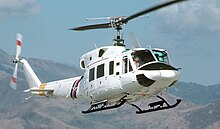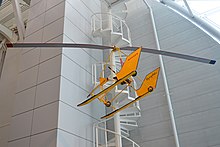Rotorcraft

Arotorcraftorrotary-wing aircraftis a heavier-than-airaircraftwith rotarywingsor rotor blades, which generateliftby rotating around a vertical mast. Several rotor blades mounted on a single mast are referred to as arotor.TheInternational Civil Aviation Organization(ICAO) defines a rotorcraft as "supported in flight by the reactions of the air on one or more rotors".[1]
Rotorcraft generally include aircraft where one or more rotors provide lift throughout the entire flight, such ashelicopters,autogyros,andgyrodynes.Compound rotorcraft augment the rotor with additional thrust engines, propellers, or static lifting surfaces. Some types, such as helicopters, are capable ofvertical takeoff and landing.An aircraft which uses rotor lift for vertical flight but changes to solely fixed-wing lift in horizontal flight is not a rotorcraft but aconvertiplane.
Classes of rotorcraft
[edit]Helicopter
[edit]
A helicopter is a powered rotorcraft with rotors driven by the engine(s) throughout the flight, allowing it to take off and land vertically, hover, and fly forward, backward, or laterally. Helicopters have several different configurations of one or more main rotors.
Helicopters with a single shaft-driven main lift rotor require some sort of antitorque device such as atail rotor,fantail,orNOTAR,except some rare examples of helicopters usingtip jetpropulsion, which generates almost no torque.
Autogyro
[edit]
An autogyro (sometimes called gyrocopter, gyroplane, or rotaplane) uses an unpowered rotor, driven by aerodynamic forces in a state ofautorotationto develop lift, and an engine-poweredpropeller,similar to that of afixed-wing aircraft,to provide thrust. While similar to a helicopter rotor in appearance, the autogyro's rotor must have air flowing up and through the rotor disk in order to generate rotation. Early autogyros resembled the fixed-wing aircraft of the day, with wings and a front-mounted engine and propeller in a tractor configuration to pull the aircraft through the air. Late-model autogyros feature a rear-mounted engine and propeller in a pusher configuration.
The autogyro was invented in 1920 byJuan de la Cierva.The autogyro with pusher propeller was first tested byEtienne Dormoywith hisBuhl A-1 Autogyro.
Gyrodyne
[edit]
The rotor of a gyrodyne is normally driven by its engine for takeoff and landing – hovering like a helicopter – with anti-torque and propulsion for forward flight provided by one or more propellers mounted on short or stub wings. As power is increased to the propeller, less power is required by the rotor to provide forward thrust resulting in reduced pitch angles and rotor blade flapping. At cruise speeds with most or all of the thrust being provided by the propellers, the rotor receives power only sufficient to overcome the profile drag and maintain lift. The effect is a rotorcraft operating in a more efficient manner than the freewheeling rotor of an autogyro in autorotation, minimizing the adverse effects of retreating blade stall of helicopters at higher airspeeds.
Rotor kite
[edit]
A rotor kite or gyroglider is an unpowered rotary-wing aircraft. Like an autogyro or helicopter, it relies on lift created by one or more sets of rotors in order to fly. Unlike a helicopter, autogyros and rotor kites do not have an engine powering their rotors, but while an autogyro has an engine providing forward thrust that keeps the rotor turning, a rotor kite has no engine at all, and relies on either being carried aloft and dropped from another aircraft, or by being towed into the air behind a car or boat.
Rotor configuration
[edit]Number of blades
[edit]A rotary wing is characterised by the number ofblades.Typically this is between two and six per driveshaft.
Number of rotors
[edit]A rotorcraft may have one or more rotors. Various rotor configurations have been used:
- One rotor. Powered rotors require compensation for the torque reaction causing yaw, except in the case oftipjetdrive. One rotor rotorcraft are typically calledmonocopters.
- Two rotors. These typically rotate in opposite directions cancelling the torque reaction so that no tail rotor or other yaw stabiliser is needed. These rotors can be laid out as
- Tandem– One in front of the other.
- Transverse– Side by side.
- Coaxial– One rotor disc above the other, with concentric drive shafts.
- Intermeshing– Twin rotors at an acute angle from each other, whose nearly-vertical driveshafts are geared together to synchronise their rotor blades so that they intermesh, also called asynchropter.
- Three rotors. An uncommon configuration; the 1948Cierva Air Horsehad three rotors as it was not believed a single rotor of sufficient strength could be built for its size. All three rotors turned in the same direction and yaw compensation was provided by inclining each rotor axis to generate rotor thrust components that opposed torque.
- Four rotors. Also referred to as thequadcopteror quadrotor. Usually two rotors turn clockwise and two counter-clockwise.
- More than four rotors. Referred to generally asmultirotors,or sometimes individually as hexacopters and octocopter, these configurations typically have matched sets of rotors turning in opposite directions.[citation needed]They are uncommon in full-size manned aircraft but are popular forunmanned aerial vehicles(UAVs).
Stopped rotors
[edit]Some rotary wing aircraft are designed to stop the rotor for forward flight so that it then acts as a fixed wing. Forvertical flightand hovering it spins to act as a rotary wing or rotor, and for forward flight at speed it stops to act as afixed wingproviding some or all of the lift required. Additional fixed wings may also be provided to help with stability and control and to provide auxiliary lift.
An early American proposal was the conversion of theLockheed F-104 Starfighterwith a triangular rotor wing. The idea was later revisited by Hughes.[3]TheSikorsky S-72research aircraft underwent extensive flight testing.
In 1986 theSikorsky S-72Rotor Systems Research Aircraft (RSRA) was fitted with a four-bladed stopped rotor, known as the X-wing. The programme was cancelled two years later, before the rotor had flown.
The later canard rotor/wing (CRW) concept added a"canard" foreplaneas well as a conventional tailplane, offloading the rotor wing and providing control during forward flight. For vertical and low-speed flight, the main airfoil is tip-driven as ahelicopter'srotor by exhaust from ajet engine,and there is no need for atail rotor.In high-speed flight the airfoil is stopped in a spanwise position, as the main wing of athree-surface aircraft,and the engine exhausts through an ordinary jet nozzle. TwoBoeing X-50 Dragonflyprototypes with a two-bladed rotor were flown from 2003 but the program ended after both had crashed, having failed to transition successfully.[4]
In 2013 the USNaval Research Laboratory(NRL) published a vertical-to-horizontal flight transition method and associated technology, patented December 6, 2011,[5]which they call the Stop-Rotor Rotary Wing Aircraft.[6]The Australian company StopRotor Technology Pty Ltd has developed a prototype Hybrid RotorWing (HRW) craft.[7][8]The design useshigh alphaairflow to provide a symmetrical airflow across all the rotor blades, requiring it to drop almost vertically during transition.[8]Inflight transition from fixed to rotary mode was demonstrated in August 2013.[9][10][11]
Another approach proposes atailsitterconfiguration in which the lifting surfaces act as a rotors during takeoff, the craft tilts over for horizontal flight and the rotor stops to act as a fixed wing.[12]
See also
[edit]References
[edit]- ^"ICAO Annex 7." Retrieved on 30 September 2009.
- ^Photo: J Thinesen,SFFArchived2009-08-28 at theWayback Machinephoto archive
- ^"Hughes Rotor Wing Brochure"Archived2018-02-27 at theWayback Machine.The Unwanted Blog (retrieved 15 May 2014)
- ^McKenna, James T. "One Step Beyond",Rotor & Wing,February, 2007, page 54
- ^""USPTO 8,070,090"".Archived fromthe originalon 2021-12-15.Retrieved2021-12-15.
- ^"Stop-Rotor Rotary Wing Aircraft"Archived2018-01-15 at theWayback Machine.Technology Transfer Office, US Naval Research Laboratory. (retrieved 16 May 2014)
- ^"Stoprotor, Hybrid Rotorwing VTOL"Archived2015-09-24 at theWayback Machine.sUAS News
- ^ab"Hybrid RotorWing design transitions from fixed to rotary wing mid-flight"Archived2016-07-16 at theWayback Machinegizmag.com
- ^Rotor & Wing"Hybrid RotorWing Conducts In-flight Fixed/Rotary Transition"Archived2016-08-13 at theWayback Machine.Rotor & Wing,30 August 2013.
- ^"Top Tech – The Flying Transformer".Archivedfrom the original on 2018-01-14.Retrieved2018-02-27.
- ^"StopRotor completes successful first transition flightArchived2014-05-08 at theWayback Machine".Australian Aviation,28 August 2013. Accessed: 7 May 2014.
- ^NASAPAV (2009-12-21),NASA Tanzenflugel VTOL UAV Concept,archivedfrom the original on 2016-12-14,retrieved2017-01-08
External links
[edit]| External videos | |
|---|---|
- American Helicopter Society
- Graham Warwick (Dec 13, 2017)."A Brief History of Rotorcraft Development".Aviation Week & Space Technology.Archived fromthe originalon October 17, 2018.RetrievedDecember 13,2017.

